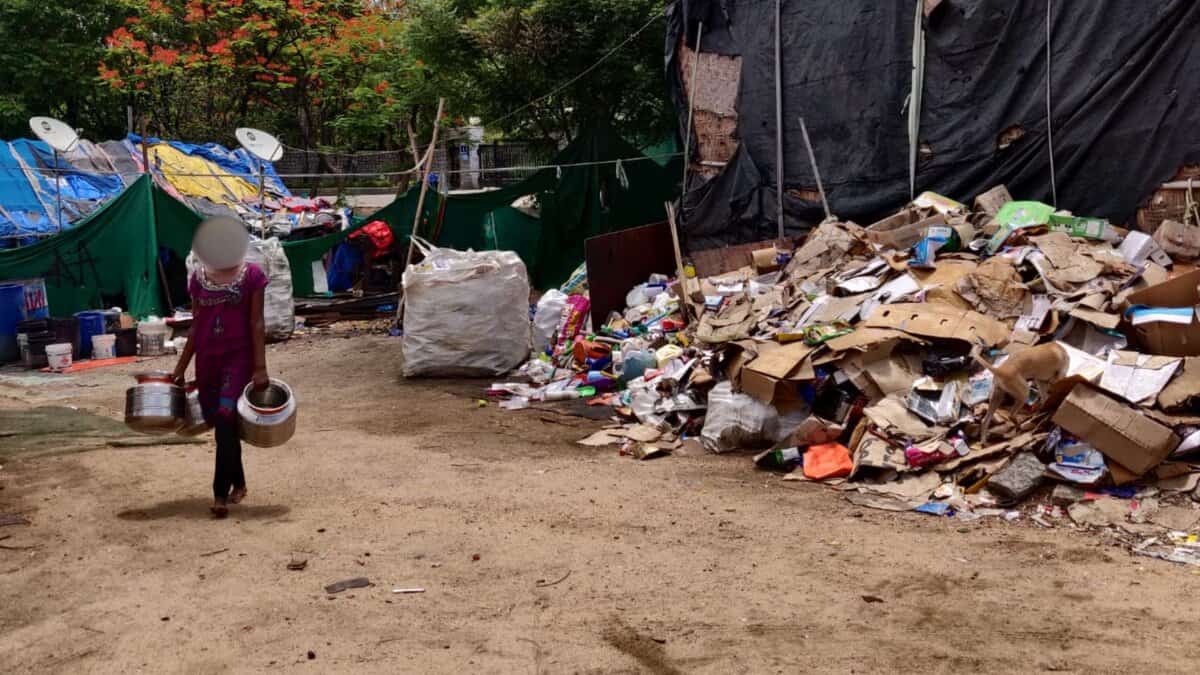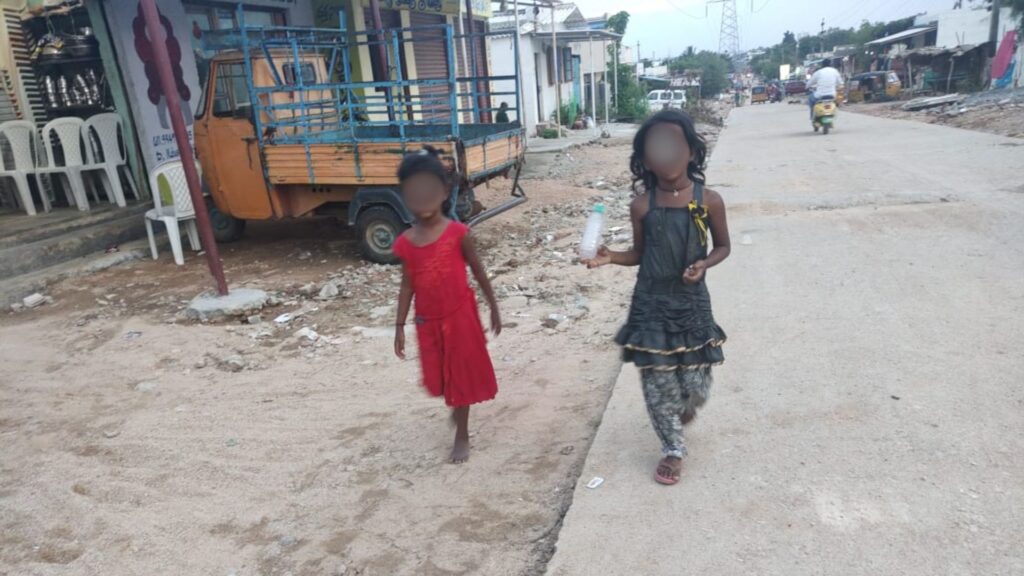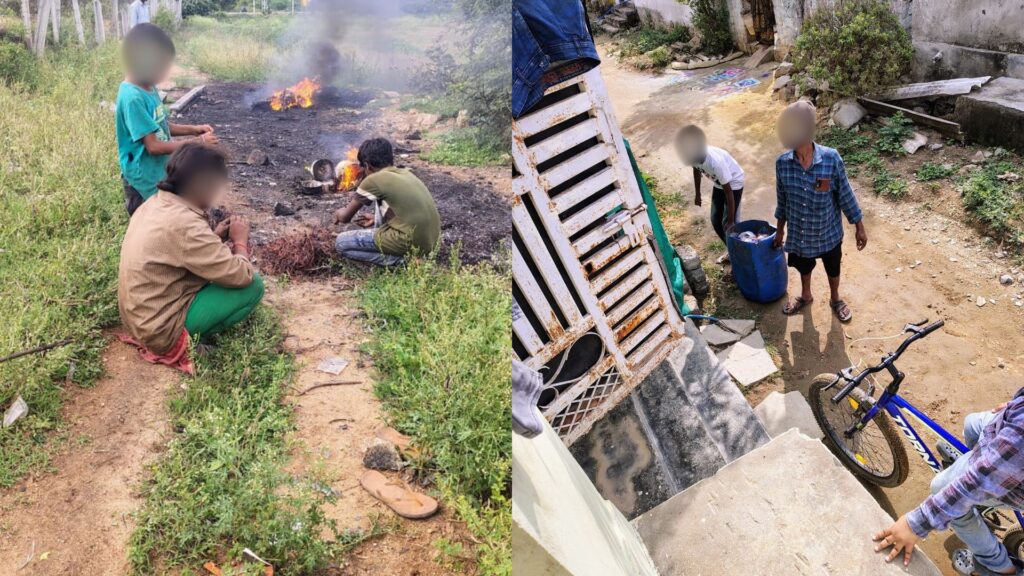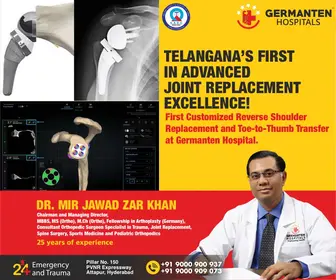
Hyderabad: “I want my children to study, unlike me, so they don’t have to suffer as I do, toiling every day at construction sites for meagre wages,” said 35-year-old Lakshmi (name changed), a single mother and construction labourer from the Giri Prasad Nagar slum.
She is one of thousands of parents demanding a school closer to home, from pre-school to Intermediate. The slum is a part of a 100-slum cluster falling under the Jawahar Nagar Municipal Corporation (JMC), Kapra Mandal, Medchal Malkajgiri district, situated in the north-east outskirts of Hyderabad.
Sitting less than 15 kilometres away from the prestigious BITS Pilani Hyderabad campus, the region is infamous for holding the city’s largest solid waste management facility, commonly referred to as the Jawaharnagar Dump Yard. The stench is pervasive, roads are poor, and streetlights are absent.

Commute to faraway schools poses risks to children
The commute to distant schools poses a risk to children. Lakshmi’s eldest daughter recently fell from an overcrowded TGSRTC bus and fractured her hand. “The bus service is unreliable. Children often have to wait for hours. It’s unsafe, and I am constantly worried,” she said, adding that she cannot afford to send her children in an auto, owing to her financial condition.
Durgesh, a local community member from Rajiv Gandhi Nagar slum, stated that some students even lost their lives in the past while travelling to faraway schools in overcrowded buses.

Two high schools for about 1.2L children
The JMC area has only two high schools and eight primary schools to cater to nearly 1.2 lakh children (total population is around 3 lakhs), a number that renders the existing infrastructure severely inadequate. Compounding this educational crisis, in 14 mandals under the Medchal-Malkajgiri district, there are no junior colleges in 9 mandals.
For the families of Jawahar Nagar, where daily wage labour and rag-picking are the primary incomes for many, private school education is out of question, placing the entire onus of their children’s future on the government system.
For many children in these slums, even completing primary schooling is not possible due to the absence of schools in their immediate vicinity.
40-year-old Jahangir Bee from Shanti Nagar slum stated that her daughter has been home since finishing 5th grade in June 2025. “I can’t send her to faraway schools, as it’s not safe. There is news of girls getting kidnapped all the time. But I want her to study,” she said.
Bee recently underwent leg surgery, and her family now relies solely on her husband’s modest and irregular income from plastic rag picking.
Community efforts and a temporary school
Following its temporary inauguration in January 2023, the Mandal Parishad Primary School (MPPS) in Gabbilalpet received no further support from the Medchal district education department, locals said.
For this reason, from June 2023 to April 2025, the community had to support the school’s entire operations, receiving no teachers, no official status, and no nutritional support for students.
After a sustained community effort, the school began operating from a rented building in Gabbilalpet slum with the government fully taking over its operations in June 2025.
Since then, MPPS Gabbilalpet now stands as a crucial respite, with three government teachers deputed to the facility and two support staff for mid-day meals and scavenging duties.
However, until very recently, the school operated without a Unified District Information System for Education (UDISE) code (granted in October 2025), a crucial identifier that enables government funding, teacher allocation, and mid-day meals.
While the school’s enrollment now stands at 120 children, the rented facility is at full capacity, forcing it to turn away additional students and highlighting the acute need for a permanent, larger building.

Land sanctions and legal hurdles
According to locals, the momentum began after the newly formed Telangana Education Commission, led by Retd IAS Akunuri Murali, intervened in May 2025, following which district authorities began moving proactively on the long-pending issue.
A district-level convergence meeting was held, placing children’s right to education at the centre of discussions and bringing together various departments to fast-track the school project.
The breakthrough appeared to come in July 2025, when the district collector issued an order for advance possession of a four-acre plot in the Gabbilalpet vicinity for a composite government school from Nursery to 12th class.
High Court stay
However, the government’s allocation was contested when private parties filed a writ petition claiming rights to the same four-acre plot. On July 31, 2025, the Telangana High Court issued an interim order directing the authorities to maintain the status quo.
The case remains pending as the court is yet to list it for a subsequent hearing, and the children of Gabbilalpet continue to await a permanent composite school in their neighbourhood.
When Siasat.com enquired about further action following the High Court stay, officials from the education department of Medchal Malkajgiri district indicated they are awaiting the court’s decision before determining next steps.
The legal impasse has created multiple challenges for students in the area. The absence of a proper school has disrupted smooth grade transitions (preschool to primary, primary to high school and high school to higher secondary) and interrupted continuous education. Additionally, students remain excluded from essential social security entitlements like mid-day meals and other welfare benefits tied to the formal schooling system.
For families grappling with deep-rooted challenges, beginning with intergenerational poverty, this lack of institutional support further entrenches their disadvantage.
Harsh consequences
This educational gap has severe consequences. Community-Based Organisations (CBOs) like the Rajiv Gandhi Nagar CBO and the Ambedkar Abhivruddi Sangham (Gabbilalpet CBO), which have taken accountability for child rights on the ground, state that the inability to study up to the 12th grade is pushing girls into child marriages and boys into child labour.
According to their knowledge, about 20 child marriages took place in five slums: Shanthi Nagar, Gabbilalpet, Giri Prasad Nagar, Rajiv Gandhi Nagar and Nandamuri Nagar, between 2022 and 25, out of which they succeeded in stopping only three. Based on data compiled by local volunteers from 662 families in these slums, approximately 136 children aged 6-18 are entirely out of school, with 45 dropouts.
Out of these 136 children, over 65 per cent are engaged in child labour.

Activists also point to the growing risk of substance abuse among children, noting that without the structure and purpose of school, children in these slums become increasingly vulnerable to addiction.
CDS data on child marriages in Telangana
The critical importance of completing intermediate education is backed by a 2024 study from the Council for Social Development (CDS). It found that in Telangana, only 9.3 percent of women with 12 or more years of education were married before 18. This is a reduction of more than 6.5 times compared to those with little or no schooling.
Despite a decline from previous years, Telangana’s child marriage rate of 23.5 percent remains marginally higher than the national average.
Within the state, the Medchal-Malkajgiri district, which encompasses the JMC slums, recorded a prevalence rate of 10.2 per cent.
There is a growing concern that without an immediate resolution, the Jawahar Nagar cluster could become a significant contributor to spiking child marriage statistics in Medchal-Malkajgiri district, potentially pushing the current 10.2 per cent prevalence rate even higher.

Community’s plea to authorities
As the community’s plea for education emerges from Jawahar Nagar’s Gabbilalpet, one is reminded of Gurram Jashuva’s ‘Gabbilam,’ where the poet voiced the anguish of marginalised communities to a bat, articulating their struggle against discrimination and society’s indifference to their suffering.
The community appeals to the state education department and relevant authorities to ensure the land allocation is completed and take necessary action at the earliest to ensure their children’s right to education is no longer denied.



